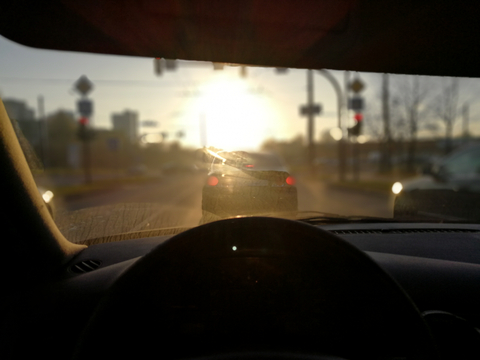Windshield: Improve safety by eliminating glass streaks, glare

You parked your car under a tree all day and decide to run some errands. As your vehicle veers around a corner it now faces directly into the sun and you are blinded by glare.
Sap, pollen, dust and road grime can greatly diminish visibility. Even a clear-looking window can become a streaky sheet of glare when faced with direct sunlight. You can eliminate visibility hazards—and the possibility of related accidents—through some simple auto glass care.
According to John Goldbach, national sales manager for Stoner Car Care Products, drivers should consider clean glass as another important safety accessory—much like a seat belt or air bag.
Founded in 1942 by Paul Stoner, a chemist who overcame an orphaned childhood and the Great Depression, the company creates products for the professional automotive detailing market. It is a past winner of the Malcolm Baldrige National Quality Award.
Clean glass helps drivers recognize road hazards and practice defensive driving, Goldbach said. What types of glass cleaners are best?
Ammonia-based products may damage film used for automotive tint, Goldbach said. Dyes used to color the liquid also may cause streaking.
"Soapy products that you find on the grocery store shelf also tend to leave residue that causes streaking," Goldbach said.
In contrast, nonwater-based cleaners use chemical reagents to remove particles-dirt, sap, road grime, exhaust pipe emissions and airborne pollutants. They do not contain soap, dyes or ammonia.
Goldbach offered the following suggestions for sparkling, streak-free auto glass:
-
Use the proper applicator.
A soft and lint-free cloth or microfiber towel is best. Crumpled newspaper makes an acceptable, inexpensive substitute. Don't use towels that may contain residual detergents or fabric softeners—both can cause streaking. Paper towels contain wetting agents that also can cause streaking.
-
Spray a thin coating
of glass cleaner. Let it loosen and dissolve dirt, insects, sap and road grime. Spray about eight inches away from the glass surface to coat evenly.
-
Gently wipe the surface
and repeat if necessary. The first cleaning removes most of the grime but trace residues remain. You may need a second or even third application to remove sticky substances and trace deposits. Remember, always use a clean cloth to prevent streaking and scratching.
-
Clean inside and edges, then buff. Clean both sides to eliminate residue from smoke, plasticizer film and airborne dirt. Roll windows down part way to clean edges. Buff glass until it is completely dry.
-
Clean wiper blades.
Build-up on the edges of wiper blades can contaminate or scratch the windshield. Drag a wetted cloth along blade edges.
"Always clean your glass surfaces after washing your car," Goldbach said. "That way you can remove soapy residue that causes streaking and hinders visibility."